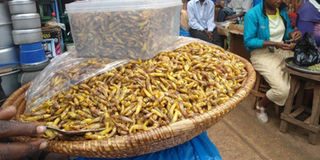Nsenene prices go high as season ends

Long-horned grasshoppers (nsenene) are a delicacy in central Uganda where they appear seasonally, usually November-December, and at times mid-year, in May. Customers’ preference vary between the dressed ones and fresh ones. This and other factors determine the prices. Photo by CHRISTINE KATENDE
Long horned–grasshoppers, locally known as nsenene in central Uganda, is not only a delicacy but remain as a source of income to most traders in and outside Kampala.
Although grasshoppers can be picked from almost anywhere they land, those with commercial intentions go an extra mile by setting up traps.
The insects, which are got from Nateete, Masaka and some parts of Mubende, according to the dealers, are trapped using metal barrels along with aluminum iron sheets and fluorescent electric bulbs that are hanged above to trap them.
These are normally placed by the roadside or in any suitable place depending on location and other factors.
Costs and quantity
But even if grasshoppers are seasonal with a relatively constant demand, prices will still vary depending on how much one invests in gathering them, transport costs to the market and the time during the season which determines the quantity.
Alice Nalwadda, who sells fresh nsenene in Nakasero Market, says: “At the beginning of the season in November, the supply was high with low prices and I could purchase a half sack between Shs40,000-Shs50,000 but now that the supply is a bit low the prices ranges from Shs200,000 to Shs300,000 depending on the size of the sack. I sell a mug between Shs8000-10,000.”
Customers’ preferences
Nalwadda adds that the fact that she deals in dressed grasshoppers (those that have been fried), she hires other people to pluck the wings and legs at Shs500-Shs1,000 a mug depending on the total quantity.
The trader points out that since the delicious insects can easily go bad, she boils the remaining stock and sells to those that need the ready-to-eat grasshoppers.
She also lays the fresh ones out on a hard paper that she places on a table under an umbrella to protect them from sun or rain.
“While plucking the legs and wings, I caution whoever that is doing the work not to remove the antennas so as to help the insects breath hence keeping them alive,” she says.
“In most cases, when grasshoppers die, they produce an offensive smell. This turns away customers, which may result into losses. No one can accept to eat smelly insects; customers always want their nsenene fresh.”
She makes between Shs50,000-Shs70,000 in net profit daily.
As other traders may be happy about the season and how much they have made, Nalwadda cites the challenge of KCCA law enforcement officers who grab their merchandise.
They accuse them selling nsenene from where they are stationed; that is, outside the market.
Price changes
Paul Kasirye Mugaaga, deals in fresh nsenene, which he sells door-to-door in search for customers who cannot walk to the market to get them.
Because Kasirye believes that not everybody can afford dressed or fried nsenene, so he sells his from as low as Shs500 depending on what one wants.
However, Hajalah Namukasa, a trader in Kireka Market, who only deals in fried grasshoppers, says the price at which she purchases the insects has gone up.
She attributes the hike in the prices to the time in current season and the other costs that those who gather the grasshoppers incur.
“Because people who trap grasshoppers incur a lot of costs like paying for the electricity, buying the drums, iron sheets, wooden poles, the places where they trap them from plus transport to the market. So, they hike prices so as to make profit. In so doing, they pass it to traders,” she notes. “This which forces us to either increase prices or reduce the quantity sold but at the same price.”
Season end
Namukasa sells the nsenene from Shs5,000 to Shs100,000 depending on the size of the package. To preserve them, she dries the grasshoppers under the sun every two days.
Normally, grasshoppers sell highly at the beginning of the season and it is around that period that many traders reap big from the business.
“I cannot close the business unless the insects stop coming. Besides, the demand is still on. By the time I joined the business, a sack could cost about Shs150,000 but now the price ranges from Shs250,000 to Shs300,000.
Comparing the last nsenene season with the current one, Namukasa explains that this time, the supply has been high with fluctuating prices.
Then, a sack cost from Shs40,000 to Shs50,000 as some traders say. Now, the price ranges from Shs200,000 to Shs300,000.
She expects the prices to go as high as Shs400,000-Shs500,000 as the season draws to an end. “The lower the supply, the higher the prices. At that time, a mug of nsenene can cost about Shs15,000,” she states.




